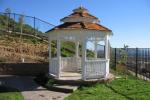Octagonal Gazebo Schematics: How to Find the Right Pergola Blueprints


Nail the jack struts to the beams and hip rafters. With these, you should have one side with no long board. They can even be built right into a porch or onto a deck, patio, or pool surround. Make sure that it's a neat, tight fit. Rent it and move it around with a dolly. Level each using a 4-foot level, and attach them to the posts using 4-inch decking screws. They provide shade, shelter, ornamental features in a landscape, (https://pergoladrafts.com/10x10-diy-square-gazebo-plans-blueprints) and a place to rest. After the concrete dries, screw or bolt the bottom of each column to a support base.
Why becomes clear in the next two steps. Each anchor consists of an unthreaded pin set into a metal sleeve. Then remove the temporary braces, backfill the hole with dirt, and cut away the exposed fiber tubing. Uneven sites would have to be built up on the low side with extra landscape timbers. Items secured by either soft-metal shields or lag shields could be easily removed, if necessary. This time, Dennis keeps his eye on the level. Gazebos are closely related, but also have some major differences. Traditional lumber products aren't your only option when designing and planning an outdoor overhead.
These are fastened with just one steel rod. Make the space functional and even more valuable by incorporating storage elements like wicker storage boxes, rolling carts, or even repurposed wooden shelves. After these first 2 pegs are in, progess around the circle until all column (click for info) holes are pegged. Your existing architecture will have a lot to do with the size of your pergola or patio cover. Paint or stain the pergola, and add plant supports. Make the notches to both ends of the beams, as shown in the plans. Once you are done with basic set up of the pergola, you can customize it to make it more exciting and define your style.
This was done to prevent the ends of the 2nd double set of headers above it from warping. Set the blade depth to cut just through the thickness of the boards, and keep the saw moving forward until completing the full pass. Fasten your eaves the same as you did for the main roof. Notching the eaves would definitely be a stronger way to tie things together than simply toe-nailing them in. These tutorials are a lot to write about all at once when we finish a big project, so it takes a while to get to them all. The second deck board is cut to length and slots directly between the posts.
A gazebo is an outdoor structure composed of four beams. Sand the whole surface with sandpaper and then apply a few coats of paint or stain to enhance the look of the carport and to protect the components from decay. If rafter spans are less than 8 feet, headers nailed across the rafter ends are adequate for garrets that sit on top of beams. Use a large round object, so you could mark the curved lines on the beams. Ensure a square layout by measuring diagonally to the plumb bob marks from the intersecting chalk lines. Stain or paint the pieces before you install them.
No strings, no guessing, and we had everything laid out and ready for digging in less than an hour. Me n the hubby would be working hard to finish our pergola. If your back yard is set up with calming features such as a pond or gazebo, then peace and quiet is something you likely enjoy. Now that the head rails are securely in place, you could go ahead and remove all of the support bracing. Install any decorative trim, making sure it is secured tightly with lag screws into the predrilled holes. Now you could go inside and install the flooring.
Note that in the bill of material you have G but you need more similar but longer. Completely build one end, including the truss, before pulling the assembly out of the way to make room for the other end. Siting the arbor is another important consideration. Install the joists that will run from the center to the frame. A pavilion is a decorative structural element to your yard that's also functional and versatile. When you buy through links on our site, we may earn a commission. Tweak each block when you set it to make it perfectly level. Secure the cap blocks and corner blocks with a bead of special construction adhesive.
This will allow for the roof decking to sit flat on the tops of the eaves and the outside edge of the fascia.